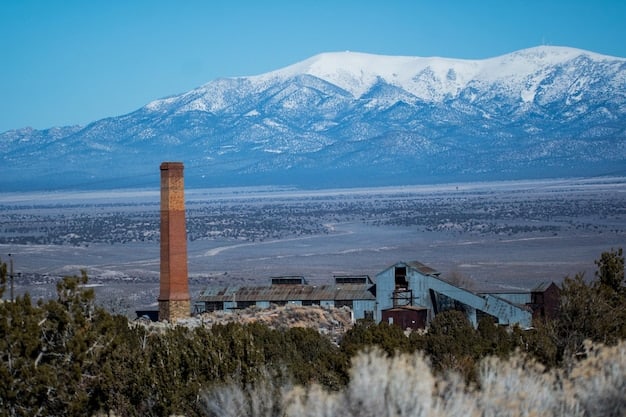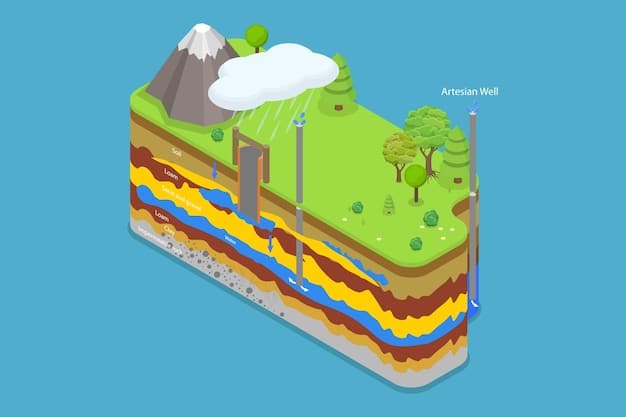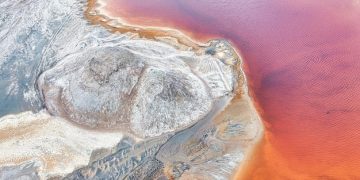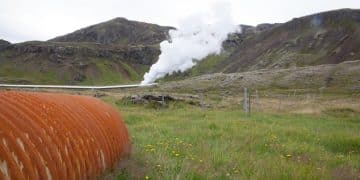Key Challenges to Scaling Up Geothermal Energy Production in the US by 2030

Scaling up geothermal energy production in the US by 2030 faces significant hurdles, including high upfront costs, technological limitations in accessing deep resources, regulatory complexities, environmental concerns related to induced seismicity and land use, and competition from cheaper energy sources.
The US has significant geothermal potential, but what are the key challenges to scaling up geothermal energy production in the US by 2030? Exploring these obstacles is essential for understanding the future of this renewable resource.
Understanding Geothermal Energy Potential in the US
Geothermal energy, derived from the Earth’s internal heat, offers a sustainable alternative to fossil fuels. Understanding its potential in the US is the first step in appreciating the challenges that lie ahead. The US possesses vast geothermal resources, particularly in the western states, capable of providing a substantial portion of the nation’s energy needs.
Geothermal Resources Across the Nation
The geothermal resources in the US are not uniformly distributed. States like California, Nevada, Utah, and Oregon have the highest potential due to their geological characteristics. These regions are part of the “Ring of Fire,” a tectonically active area with abundant geothermal reservoirs.
- California: Home to the Geysers, the world’s largest geothermal field, California has been a leader in geothermal energy production for decades.
- Nevada: Known for its hot springs and geothermal activity, Nevada has numerous geothermal power plants and significant untapped potential.
- Utah and Oregon: These states also have substantial geothermal resources and are actively developing new projects.
Despite the concentration in the West, Enhanced Geothermal Systems (EGS) could unlock geothermal potential in other regions by accessing heat from dry rock formations. This would expand the geographic viability of geothermal energy across the US.

Geothermal energy offers a reliable and consistent power source, unlike solar and wind, which are intermittent. Geothermal power plants can operate 24/7, providing baseload power that supports grid stability and reduces reliance on fossil fuels. This reliability is a major advantage in the transition to a cleaner energy future.
The Economic Hurdles of Geothermal Energy
Economic factors play a significant role in determining the feasibility of scaling up geothermal energy production. High upfront costs, long lead times, and competition with cheaper alternatives pose substantial challenges. Addressing these economic barriers is crucial for attracting investment and fostering growth in the geothermal sector.
High Upfront Costs and Long Lead Times
Developing geothermal projects requires significant capital investment. Exploration, drilling, and power plant construction are expensive and time-consuming. The initial investment can be a major deterrent for potential developers.
The long lead times associated with geothermal projects also contribute to the economic challenges. It can take several years from initial exploration to the commissioning of a power plant, delaying returns on investment and increasing financial risk.
Competition with Other Energy Sources
Geothermal energy faces stiff competition from other energy sources, particularly natural gas, solar, and wind. Over the past decade, the cost of solar and wind energy has decreased dramatically, making them more economically attractive in many regions.
- Natural Gas: Abundant and relatively cheap, natural gas remains a dominant source of electricity in the US, providing a cost-effective alternative to geothermal.
- Solar and Wind: With rapidly declining costs and increasing efficiency, solar and wind energy are becoming increasingly competitive.
- Subsidies: Government subsidies and incentives for renewable energy often favor solar and wind, putting geothermal at a disadvantage.
Geothermal developers must demonstrate the long-term economic viability of their projects to attract investors and compete with these established and emerging energy sources. Innovation and cost reduction are essential for geothermal to thrive in a competitive market.
Technological Limitations and Innovations
Technological advancements are crucial for unlocking geothermal energy’s full potential. Overcoming current limitations and developing innovative solutions can significantly enhance the efficiency and viability of geothermal projects. Enhanced Geothermal Systems (EGS) and advanced drilling techniques are key areas of focus.
Enhanced Geothermal Systems (EGS)
EGS involves creating artificial geothermal reservoirs in hot, dry rock formations. This technology has the potential to expand geothermal energy production to regions without naturally occurring hydrothermal resources. However, EGS projects face significant technical challenges. Creating and maintaining fractures in deep rock formations is complex and expensive.
Research and development efforts are focused on improving EGS technology, including: enhancing fracture creation techniques, optimizing reservoir management, and reducing drilling costs. Successful implementation of EGS could dramatically increase geothermal energy production in the US.
Advanced Drilling Technologies
Drilling deep into the Earth to access geothermal resources is a costly and challenging undertaking. Traditional drilling methods can be slow and inefficient, particularly in hard rock formations. Advanced drilling technologies are being developed to reduce costs and improve drilling efficiency. These include:
- Laser Drilling: Using high-powered lasers to cut through rock, offering faster drilling speeds and reduced wear on equipment.
- Millimeter Wave Drilling: Employing millimeter waves to heat and weaken rock, making it easier to drill.
- Automated Drilling Systems: Utilizing robotic systems to automate drilling operations, improving accuracy and reducing human error.

These and other technological innovations are essential for overcoming the technical barriers to geothermal energy development. By investing in research and development, the US can unlock its vast geothermal potential and accelerate the transition to a cleaner energy future.
Regulatory and Policy Challenges
Government regulations and policies play a critical role in shaping the development of geothermal energy. Streamlining permitting processes, providing financial incentives, and establishing clear regulatory frameworks are essential for fostering growth in the geothermal sector. Addressing these regulatory and policy challenges is crucial for unlocking geothermal’s full potential.
Permitting and Regulatory Processes
The permitting process for geothermal projects can be lengthy and complex, involving multiple federal, state, and local agencies. Navigating this regulatory maze can be time-consuming and expensive, delaying project development and increasing financial risk.
Streamlining the permitting process requires improved coordination among regulatory agencies, clear and consistent guidelines, and efficient review timelines. Expediting the permitting process can reduce project costs and accelerate the deployment of geothermal energy.
Financial Incentives and Support
Government financial incentives, such as tax credits, grants, and loan guarantees, can help reduce the financial burden of geothermal projects and attract private investment. These incentives can make geothermal energy more competitive with other energy sources and stimulate growth in the sector.
- Tax Credits: Providing tax credits for geothermal energy production can reduce project costs and improve financial returns.
- Grants: Offering grants for research, development, and demonstration projects can support innovation and accelerate the deployment of new technologies.
- Loan Guarantees: Providing loan guarantees can reduce financial risk and make it easier for geothermal developers to secure financing.
Consistent and long-term policy support is essential for creating a stable investment environment and fostering sustained growth in the geothermal sector. A clear and predictable regulatory framework can provide confidence to investors and encourage the development of geothermal energy projects.
Environmental Considerations and Public Perception
Environmental concerns and public perception can significantly impact the development of geothermal energy. Addressing these concerns through careful planning, mitigation measures, and transparent communication is crucial for gaining public acceptance and ensuring the sustainable development of geothermal resources.
Induced Seismicity and Water Usage
One of the primary environmental concerns associated with geothermal energy is induced seismicity. The injection of fluids into the Earth to create or enhance geothermal reservoirs can trigger earthquakes, particularly in areas with existing fault lines. Mitigating the risk of induced seismicity requires careful site selection, monitoring, and management of fluid injection.
Water usage is another environmental concern. Geothermal power plants require water for cooling and reservoir management. In arid regions, water scarcity can be a limiting factor. Implementing water-efficient technologies and utilizing alternative water sources, such as treated wastewater, can help minimize water usage and reduce environmental impacts.
Land Use and Visual Impact
Geothermal power plants and associated infrastructure can have a significant land footprint, impacting local ecosystems and visual landscapes. Careful site planning and design can help minimize these impacts. Utilizing existing industrial areas and brownfield sites can reduce the need for new land development.
Public perception of geothermal energy can be influenced by environmental concerns and visual impacts. Transparent communication, community engagement, and environmental stewardship are essential for building public support and ensuring the sustainable development of geothermal resources.
Addressing these environmental considerations and promoting public awareness can help overcome barriers to geothermal energy development and foster a more sustainable energy future.
Infrastructure and Grid Integration
Developing the necessary infrastructure and integrating geothermal energy into the existing electricity grid are essential for scaling up geothermal energy production in the US. Transmission lines, grid modernization, and energy storage solutions are key components of this infrastructure development. Addressing these challenges is crucial for fully utilizing geothermal resources and ensuring a reliable energy supply.
Transmission Lines and Grid Modernization
Many geothermal resources are located in remote areas, far from major population centers. Developing new transmission lines to transport geothermal electricity to load centers is essential. This requires significant investment and coordination among utilities, developers, and government agencies.
- Grid Modernization: Upgrading the existing electricity grid to accommodate intermittent renewable energy sources, such as solar and wind, is also crucial for integrating geothermal energy.
- Smart Grids: Implementing smart grid technologies can improve grid efficiency, reliability, and resilience, making it easier to integrate geothermal energy.
Modernizing the electricity grid requires significant investment and policy support. Streamlining regulatory processes, providing financial incentives, and promoting collaboration among stakeholders are essential for fostering grid modernization and enabling the integration of geothermal energy.
Energy Storage Solutions
Energy storage solutions, such as batteries and pumped hydro storage, can help address the intermittency challenges of renewable energy sources. While geothermal energy provides baseload power, integrating it with energy storage can enhance grid stability and improve the utilization of geothermal resources.
Investing in infrastructure development and grid modernization is crucial for scaling up geothermal energy production in the US. By addressing these challenges, the US can unlock its vast geothermal potential and accelerate the transition to a more sustainable energy future.
| Key Point | Brief Description |
|---|---|
| 💰 High Upfront Costs | Geothermal projects require significant initial investment for exploration and construction. |
| ⚙️ Technological Limitations | Accessing deep geothermal resources often requires advanced and costly technologies. |
| 📜 Regulatory Complexities | Permitting processes for geothermal projects can be lengthy and involve multiple agencies. |
| 🌎 Environmental Concerns | Induced seismicity and water usage are significant environmental concerns associated with geothermal projects. |
Frequently Asked Questions
▼
Geothermal energy is heat derived from the Earth’s internal heat. This heat can be used to generate electricity or for direct heating applications, offering a sustainable energy source.
▼
The major geothermal resources in the US are primarily located in the western states, including California, Nevada, Utah, and Oregon, due to their geological activity.
▼
EGS involves creating artificial geothermal reservoirs in hot, dry rock formations. This technology has the potential to expand geothermal energy production to regions without natural hydrothermal resources.
▼
Induced seismicity can be mitigated through careful site selection, monitoring of seismic activity, and responsible management of fluid injection during geothermal operations.
▼
Financial incentives for geothermal energy development include tax credits, grants, and loan guarantees aimed at reducing project costs and attracting private investment in the sector.
Conclusion
Scaling up geothermal energy production in the US by 2030 presents numerous challenges, ranging from economic and technological barriers to regulatory hurdles and environmental concerns. Overcoming these obstacles requires a concerted effort from government, industry, and research institutions to foster innovation, streamline regulatory processes, and promote sustainable development practices. By addressing these challenges, the US can unlock its vast geothermal potential and accelerate the transition to a cleaner and more sustainable energy future.





